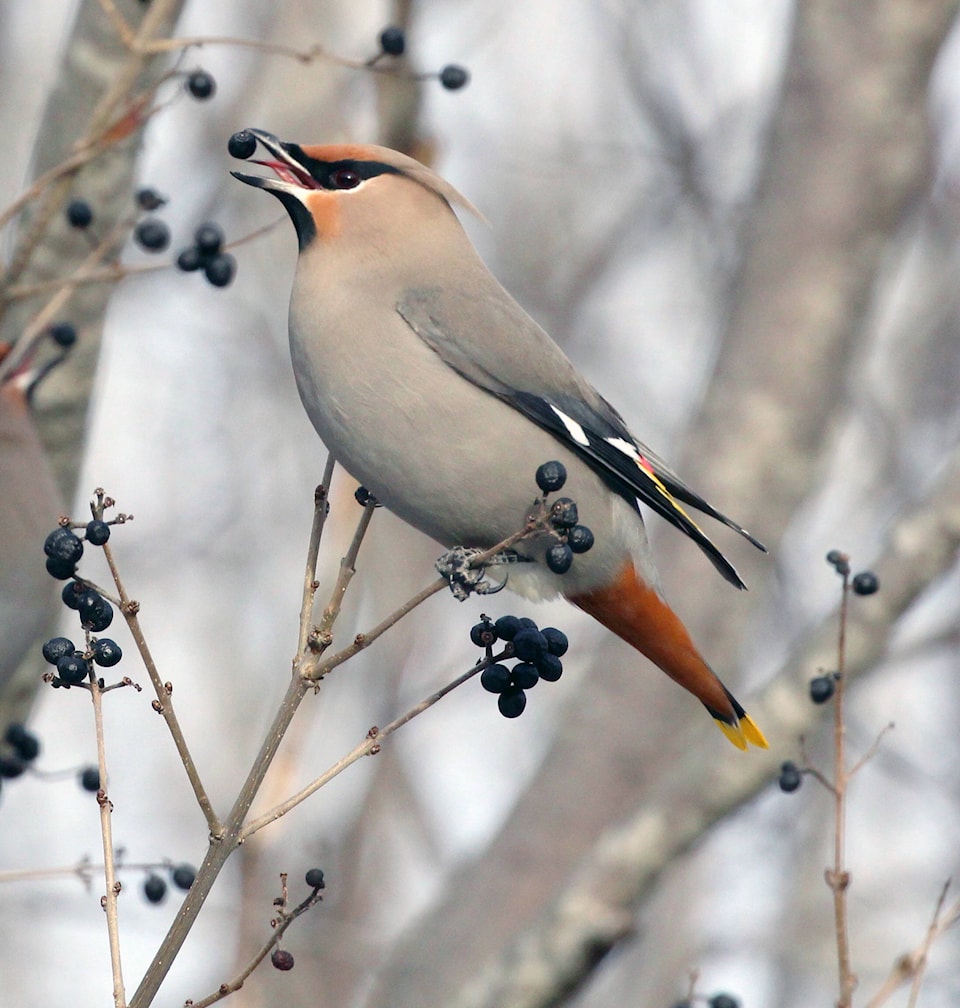As snow falls and the temperature drops, why would certain birds bother sticking around the North Okanagan when they could wing their way south?
Actually, the long journey of migration is taxing on birds. Winter residents, on the other hand, have had to adapt to winter conditions to survive here. The most critical adaptations are their ability to get food and stay warm.
Most migrating birds depend on flying insects for their prey, requiring they return south to unfrozen climes where bugs flourish. The wintering bird residents that remain here can loosely be divided into four categories depending on their food sources; predators, scavengers, seed and berry eaters, and bark gleaners.
Raptors such as eagles, owls, hawks and falcons prey on rodents, small birds and animals; all active throughout the winter. Next time you drive through the Commonage (by Predator Ridge), take your binoculars. Not only are birds easier to spot on the leafless trees but the Commonage has an amazing diversity of wintering raptors. Scan your binoculars up the trunks of trees in sheltered draws to find them.
So long as lakes maintain open water for fishing, Bald Eagles, herons and waterfowl such as loons, grebes, merganzers and geese can be seen. Scavengers, such as magpies, ravens, jays, and gulls opportunistically consume pet food, garbage, road kills and wildlife carcasses. Thus, they tend to be less shy and bolder around people. Seed and berry eaters such as crossbills, waxwings, finches, sparrows, grosbeaks, chickadees and nuthatches are mostly found on coniferous trees, berry shrubs and in weedy fields. Large, old trees and snags are havens for insects overwintering in bark crevices like spiders, butterflies and moths; under bark such as beetle larvae and springtails; in wood such as ants; or on buds or needles such as various eggs and larvae. Jays, chickadees, nuthatches, kinglets, creepers and woodpeckers glean these trees. Some birds even stash food away for later pickings. Chickadees store insects, spiders and seeds in bark crevasses.
Birds tend to be more territorial during winter to protect their food sources. They’ll often band up in protective flocks creating “portable” territories with boundaries defined by available food. Once consumed, they move on to reestablish a new territory.
How do birds stay warm in winter? They grow insulating down under their regular contour feathers which keeps them cozy in the same way down coats keep us warm. This gives them a “chubbier” appearance in the winter. Birds raise their metabolic rate during colder weather requiring almost continual eating. They seek sheltered spots to stay warm or dig into snowbanks or under brush piles. Some huddle together.
You’d think birds feet would freeze. Their secret; birds arteries and veins in the legs lie in contact with each other, working as a heat exchanger system. Another foot-warming strategy is leg tucking. Sometimes you’ll see a duck or gull standing on one leg on the ice; keeping one warm, then changing. Ground birds, such as grouse, grow scales on their feet to manoeuvre on snow.
There’s a debate over feeding wild birds. In urban areas, where native plants have been removed, feeders may be helpful, but they’re like fast food outlets. It’s better to grow the native plants that they depend on, or leave natural areas for birds, butterflies and other small wildlife to forage, nest and rest on. We can help birds by observing their natural behaviours and by Naturescaping - landscaping with native trees, shrubs and flowers to enhance our yards for wildlife.
Discover our local winter birds on the North Okanagan Naturalists Club Saturday hikes open to the public — nonc.ca. And the Swan Lake Nature Reserve Park off Old Kamloops Road has great winter walking trails, interpretive signs and sky views.
Roseanne enthusiastically shares her knowledge of the outdoors to help readers experience and enjoy nature. Discover exciting and adventurous natural events, best trails, and wild places. Follow her on Facebook for more.
